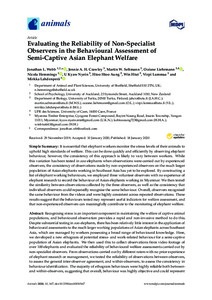Evaluating the Reliability of Non-Specialist Observers in the Behavioural Assessment of Semi-Captive Asian Elephant Welfare
Jonathan L. Webb; Jennie A. H. Crawley; Martin W. Seltmann; Océane Liehrmann; Nicola Hemmings; U Kyaw Nyein; Htoo Htoo Aung; Win Htut; Virpi Lummaa; Mirkka Lahdenperä
https://urn.fi/URN:NBN:fi-fe2021042823794
Tiivistelmä
Recognising stress is an important component in maintaining the welfare of captive animal populations, and behavioural observation provides a rapid and non-invasive method to do this. Despite substantial testing in zoo elephants, there has been relatively little interest in the application of behavioural assessments to the much larger working populations of Asian elephants across Southeast Asia, which are managed by workers possessing a broad range of behavioural knowledge. Here, we developed a new ethogram of potential stress- and work-related behaviour for a semi-captive population of Asian elephants. We then used this to collect observations from video footage of over 100 elephants and evaluated the reliability of behavioural welfare assessments carried out by non-specialist observers. From observations carried out by different raters with no prior experience of elephant research or management, we tested the reliability of observations between-observers, to assess the general inter-observer agreement, and within-observers, to assess the consistency in behaviour identification. The majority of ethogram behaviours were highly reliable both between- and within-observers, suggesting that overall, behaviour was highly objective and could represent easily recognisable markers for behavioural assessments. Finally, we analysed the repeatability of individual elephant behaviour across behavioural contexts, demonstrating the importance of incorporating a personality element in welfare assessments. Our findings highlight the potential of non-expert observers to contribute to the reliable monitoring of Asian elephant welfare across large captive working populations, which may help to both improve elephant wellbeing and safeguard human workers.
Kokoelmat
- Rinnakkaistallenteet [27094]
